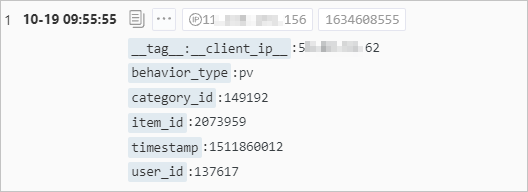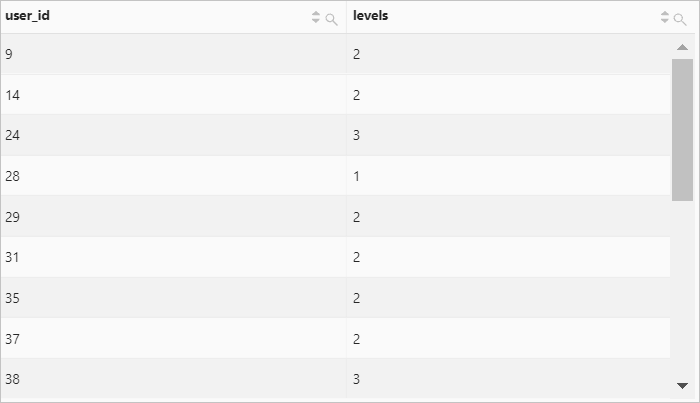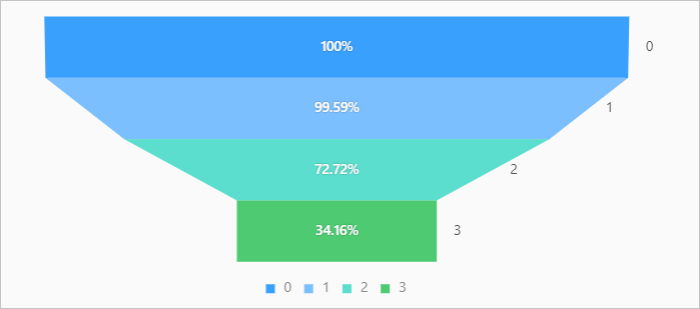Simple Log Service provides window funnel functions. You can use the functions to analyze data, such as user behavior, application traffic, and product goal conversion. This topic describes the syntax of window funnel functions. This topic also provides examples on how to use the functions.
The following table describes the window funnel functions that are supported by Simple Log Service.
Function | Syntax | Description | Supported in SQL | Supported in SPL |
window_funnel(sliding_window, timestamp, event_id, ARRAY[event_list01, event_list02...]) | Searches for an event chain in a sliding time window and counts the maximum number of consecutive events in the event chain. If the value of the event_id parameter is specified in an event chain, you can use this syntax. | √ | × | |
window_funnel(sliding_window, timestamp, ARRAY[event_id=event_list01, event_id=event_list02...]) | Searches for an event chain in a sliding time window and counts the maximum number of consecutive events in the event chain. If the value of the event_id parameter is not specified in an event chain and you want to use a custom value for the event_id parameter, you can use this syntax, which is more flexible. | √ | × |
Implementation
Window funnel functions are used to search for an event chain in a sliding time window and count the maximum number of consecutive events in the event chain. Window funnel functions start the count from the first event in the event chain that you specify, check the events in sequence, and then return the maximum number of consecutive events.
A window funnel function works based on the following algorithm:
The function starts the count from the first event in the event chain and sets the initial value of the event counter to 1. Then, the sliding time window starts.
In the sliding time window, if events in the event chain occur in sequence, the event counter is incremented.
In the sliding time window, if the sequence of events in the event chain is disrupted, the event counter stops. The search stops, and a new search starts. The maximum number of consecutive events is counted until the end of the last search.
At the end of the last search, if multiple values of the count exist, the function returns the maximum value of the count. The maximum value of the count indicates the maximum number of consecutive events.
For example, you specify a sliding time window of 100 seconds and the following pattern for the event chain: Event 1, Event 2, Event 3, Event 4, and Event 5. However, the events in the event chain occur in the following sequence: Event 1, Event 2, Event 4, Event 5, Event 1, and Event 3. In the sliding time window, the maximum number of consecutive events is 2. A value of 2 indicates the sequential relationship between Event 1 and Event 2.
The function must start the count from the first event in the event chain. For example, if the function starts the count in the sequence of Event 2, Event 3, and Event 4, the function returns 0.
The function must count all events that occur in the event chain. For example, Event 4 occurs in the sliding time window but Event 3 does not. In this case, this search is not involved in counting the maximum number of consecutive events.

Syntax
The following table describes the window funnel functions that are supported by Simple Log Service.
If the value of the event_id parameter is specified in an event chain, you can use the following syntax:
window_funnel(sliding_window, timestamp, event_id, ARRAY[event_list01, event_list02...])If the value of the event_id parameter is not specified in an event chain and you want to use a custom value of the event_id parameter, you can use the following syntax, which is more flexible:
window_funnel(sliding_window, timestamp, ARRAY[event_id=event_list01, event_id=event_list02...])
Parameters
Parameter | Description |
sliding_window | The sliding time window. Unit: seconds. The value of this parameter is of the bigint type. |
timestamp | The timestamp. Unit: seconds. The value of this parameter is of the bigint type. We recommend that you use the built-in __time__ field of Simple Log Service. |
event_id | The name of the log field. The value of this parameter is the name of an event. Example: Event A, Event B, or Event C. The value of this parameter is of the varchar type. |
event_list | The custom event chain, which can contain up to 32 events. The value of this parameter is of the array type. Examples:
|
Examples
An e-commerce store hosted a promotional activity and analyzed the conversion performance of the activity by using window funnel functions. The conversion process consists of three steps: browsing information about a commodity, adding the commodity to the online shopping cart, and then purchasing the commodity. The following figure shows a sample log that is collected by Simple Log Service.

Log field | Description |
behavior_type | The type of user behavior. Valid values:
|
category_id | The category ID of the commodity. |
item_id | The ID of the commodity. |
timestamp | The point in time at which the user behavior occurred. |
user_id | The ID of the user. |
Example 1
Analyze the purchase behavior that users performed within 24 hours.
Query statement
* | SELECT user_id, window_funnel( 86400, timestamp, ARRAY [behavior_type='pv', behavior_type='cart',behavior_type='buy'] ) AS levels GROUP BY user_id ORDER BY user_id LIMIT 1000Query and analysis results
The value of the levels field is 3 for user 24. The user completes the purchase in the sequence of browsing information about a commodity, adding the commodity to the online shopping cart, and then purchasing the commodity.
The value of the levels field is 2 for user 14. The user browses information about a commodity and adds the commodity to the online shopping cart but does not complete the purchase.

Example 2
Analyze the numbers of users who have different types of user behavior.
Query statement
* | SELECT levels, count, sum(count) over( ORDER BY levels DESC ) AS total FROM ( SELECT levels, count(1) AS count FROM ( SELECT user_id, window_funnel( 86400, timestamp, ARRAY [behavior_type='pv', behavior_type='cart',behavior_type='buy'] ) AS levels FROM log GROUP BY user_id ) GROUP BY levels ORDER BY levels )Query and analysis results
The number of users who browse information about a commodity is 513,194. The number of users who do not continue their purchase process after they browse information about the commodity is 138,491.
The number of users who add the commodity to the online shopping cart is 374,703. The number of users who do not continue the purchase process after they add the commodity to the online shopping cart is 198,642.
The number of users who purchase the commodity is 176,061.

Example 3
Calculate the conversion rate of this promotional activity.
Absolute conversion rate: the proportion of the users who perform a type of user behavior to the total number of users.
Relative conversion rate: the proportion of the users who perform a type of user behavior to the users who perform a different type of user behavior. The latter type of user behavior occurred before the former type of user behavior.
Query statement
* | SELECT *, 100.0 * total /(sum(count) over()) AS "Absolute conversion rate", if( lag(total, 1, 0) over() = 0, 100, (100.0 * total / lag(total, 1, 0) over()) ) AS "Relative conversion rate" FROM ( SELECT levels, count, sum(count) over( ORDER BY levels DESC ) AS total FROM ( SELECT levels, count(1) AS count FROM ( SELECT user_id, window_funnel( 86400, timestamp, ARRAY [behavior_type='pv', behavior_type='cart',behavior_type='buy'] ) AS levels FROM log GROUP BY user_id ) GROUP BY levels ) ORDER BY levels )Query and analysis results
Query and analysis results in a table

Query and analysis results in a funnel chart
